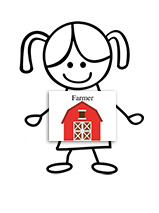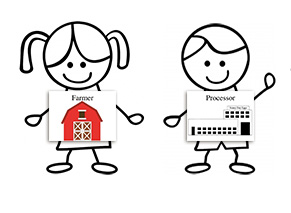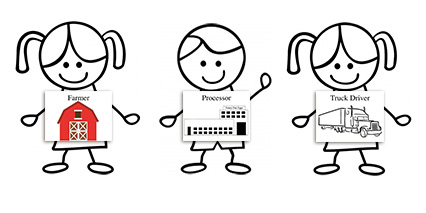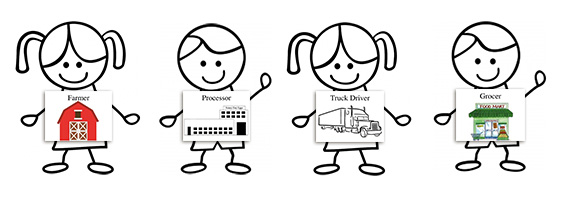Agricultural Literacy Curriculum Matrix
Agricultural Literacy Curriculum Matrix
Lesson Plan
Eggs: From Hen to Home (Grades K-2)
Grade Level
Purpose
Students trace the production path of eggs, beginning on the farm and ending in their home and identify the culinary uses and nutritional benefits of eggs. Grades K-2
Estimated Time
Materials Needed
Activity 1: Hen to Home
- Hen to Home PowerPoint Slides
- Computer and LCD Projector
- Hen to Home Role Play Signs (Print 1 copy)
- Small box (shoebox size)
- Egg collecting basket
- Wash basin with water (or sink)
- Towel
- 1 or 2 dozen eggs in a carton
- Flashlight
Elaborate
Vocabulary
coop: an enclosure where poultry live
egg: an oval or round object laid by a female bird
hen: an adult female chicken
Did You Know?
- The process of an egg traveling from "Hen to Home" takes approximately a week or less.
- When refrigerated, eggs have a shelf life of 3-5 weeks!
- The majority of eggs purchased in a grocery store have white shells and were produced by a White Leghorn, a breed of chicken known for their egg production.
Background Agricultural Connections
Eggs are produced by hens (female chickens) on farms. Hens begin laying eggs when they are 4-6 months old. A good laying hen will produce 6-7 eggs per week for the first 1-2 years of her life. Chickens are domestic fowl, as are turkeys, ducks, and geese. All species of poultry lay eggs. Chicken eggs are most commonly consumed in the United States. Eggs are produced by female chickens which are called hens.
Eggs come in various shell colors, although there is no nutritional difference between different colored eggs. The shell color depends upon the breed of chicken. Eggs can be white, tan, brown, or even a light shade of green. Chickens can be raised on a large or small scale. A few chickens can easily be raised in a backyard to provide eggs for a family. Eggs that are purchased from a store likely came from a farm. Chickens live in houses called a coop. They eat a special feed that include grains, such as ground up corn and wheat.
Eggs that are produced for the purpose of eating will never develop into a chick because the eggs are not fertilized by a rooster nor are they ever incubated (kept warm). On a farm, eggs are collected each day. The eggs then go through a processing plant where they are washed, checked for abnormalities, and then packaged. The contents of an egg can be seen by holding it up to a light. If an egg has an abnormal shape or appearance, it is discarded and the remaining eggs are packaged into cartons. The eggs leave the processing plant in refrigerated trucks which deliver the eggs to retail grocery stores to be sold to consumers.
Egg Nutrition
The 2020-2025 Dietary Guidelines for Americans includes eggs in all three of its healthy eating patterns. The nutrients in eggs support brain development in early life and health across the lifespan.1 Eggs are a good source of protein and are a good or excellent source of eight essential nutrients including choline, an under-consumed nutrient the Dietary Guidelines recommend to support brain health. Eggs are one of the few natural food sources of vitamin D, which along with calcium is critical for building strong bones. Egg yolks contain lutein and zeaxanthin, carotenoids that can support eye health as you age. The science on dietary cholesterol and eggs continues to grow and demonstrates that eggs are an important part of healthy dietary patterns across the lifespan.2
Though eggs can be prepared in various ways for breakfast, they are also important and commonly used in other foods. Eggs help bind ingredients together, act as a leavening agent, and help to thicken soups and sauces.
Engage
- Ask your students what they had for breakfast. Identify the students who had eggs for breakfast. Ask them how their eggs were prepared. Were they scrambled, fried, or boiled? Were they in an omelet? Do they know that eggs are used to make pancakes and waffles too?
- Ask the students if they know where the eggs came from. Was it the grocery store? Where were they before the grocery store? Today they are going to find out!
Explore and Explain
Activity 1: Hen to Home
Preparation: Before class, take the eggs out of the carton and place them in a box that is labeled "nest." This box will represent the nest box where hens lay their eggs on the farm. Keep the cartons handy for step 3 of the lesson.
- Project the Hen to Home PowerPoint Slides in the front of the class.
- Begin with slide 2, titled "Farm." Choose one student to be the farmer. Explain to the student and the class that they raise chickens on their farm. Female chickens are called "hens" and hens lay eggs. Now ask the "farmer" to take the egg basket and collect the eggs from the "nest." As he/she is doing so, explain that chickens live in special pens or houses that are called "coops." The farmer makes sure that the hens have food and water. Naturally, hens like to lay their eggs in a nest or box. Explain that feeding, watering, and collecting eggs each day are chores an egg farmer would complete. Once the "farmer" has collected the eggs, ask them to stay in front of the class holding their sign. Using slides 3, 4, and 5, teach the students how many eggs a chicken lays per day, what they eat, and what color eggs are.

- While displaying slide 6, titled "Processing Plant" choose another student to be the processing plant worker. Ask the farmer to give the eggs to the student who is the processor. Explain that after eggs arrive at the processing plant, they are cleaned. Have the student wash the eggs in a wash basin with water or at a sink in your classroom and then place the eggs on a towel to dry. After the eggs are washed at the processing plant, they look at the inside of the egg by using a bright light. Ask the students if they know what is inside an egg. Display slide 7 and point out the yolk, white, and shell. Pick up one of the eggs and point out the shell. Then, turn the lights off and use the flashlight to see inside of the egg. This process is called candling. The students should be able to see the yolk and the white. (White shelled eggs are easiest to see inside.) The last task for the processor to complete is to place the clean, dry eggs in an egg carton. Ask the "processor" to stand to the left of the "farmer" with their sign.
- Teacher Tip: When candling an egg with a regular flashlight, seal your thumb and forefinger in a circle around the end of the flashlight and place the egg on top. This will help direct all of the light through the egg, making the inside of the egg more visible.

- Teacher Tip: When candling an egg with a regular flashlight, seal your thumb and forefinger in a circle around the end of the flashlight and place the egg on top. This will help direct all of the light through the egg, making the inside of the egg more visible.
- While displaying slide 9 titled "Transportation," choose a student to be the truck driver. Ask the student playing the role of the processor to hand the carton of eggs to the truck driver. Explain to the students that the truck driver puts the eggs in the truck and transports the eggs to the grocery store. Eggs are transported in special trucks that are refrigerated to keep the eggs cool and fresh. To simulate the truck driving to the store, walk with the student "truck driver" around the perimeter of the classroom carrying the eggs. Explain that sometimes eggs have to travel many miles to arrive at the grocery store. Once you have reached the front of the classroom again, have the "truck driver" stand to the left of the "processor" holding their sign.

- While displaying slide 10 titled "Grocery Store," choose a student to be the grocer. Ask the "truck driver" to deliver the carton of eggs to the grocer. Explain to the class that once the eggs arrive at the grocery store, they are placed on a shelf in a refrigerator until someone purchases them. Ask the "grocer" to place the eggs on a "shelf" (nearby table or desk) and then stand to the left of the truck driver with their sign.

- While displaying slide 11 titled "Home," choose a student to represent a mom or dad at the grocery store. Ask the student to pick up the carton of eggs, pretend to pay for them, and take them home. Use slides 12, 13, and 14 to teach students about the nutrition found in eggs and the different foods that contain eggs. Ask the student representing the consumer to stand to the left of the grocer.

- With all 5 students standing in front of the class, review the steps an egg passes through to get from "Hen to Home."
Activity 2: Egg Nutrition
- Explain to the students that eggs contain nutrients that are important for their health.
- Have the students stand up and point to each part of the body listed below as you name them. Point to an arm or leg when naming bones and blood, but clarify that we have bones all over our body and that our blood travels throughout our entire body.
- Brain
- Stomach
- Heart
- Blood
- Eyes
- Muscles
- Bones
- Explain to the students that all of the parts of their body that were just named can be benefitted from eating eggs. Sing the name of and point to each part of the body to the tune of "Head, Shoulders, knees, and Toes."
Brain, stomach, heart, and blood,
Heart and blood, heart and blood.
Brain, stomach, heart, and blood,
Eyes, muscles, and my bones.
Elaborate
-
Have students color and complete the "A "MAZE" ing Egg" activity sheet.
-
If any of your students have their own chickens, invite the student to bring some eggs from home. Compare the size and color(s) of the eggs with those that are typically purchased from the grocery store.
-
Play the Egg Nutrition Memory Game.
Evaluate
After conducting this activity, review and summarize the following key concepts:
- A female chicken, called a hen, is raised on a farm to produce eggs for us to eat.
- Hens can lay about one egg per day once they are full grown.
- Eggs are produced on a farm, cleaned and packaged at a processing plant, transported to a grocery store, then finally sold to a consumer.
Sources
- https://www.dietaryguidelines.gov/sites/default/files/2020-07/ScientificReport_of_the_2020DietaryGuidelinesAdvisoryCommittee_first-print.pdf
- https://www.incredibleegg.org/articles/eggs-and-heart-health
Acknowledgements
A "MAZE" ing Egg activity sheet provided by Utah Agriculture in the Classroom.
Recommended Companion Resources
- All About Eggs
- Chick Life Cycle
- Chicken Embryo Development
- Chickens on the Farm
- Chicks & Chickens
- Daisy Comes Home
- Eat Happy Project Video Series
- Eggs 101: An Egg's Journey from the Farm to Our Tables
- Eggs in Schools
- Farm Animals: Chickens
- Hatching Chicks in Room 6
- Hatching Science: 21 Days of Discovery Video
- How Food gets from Farms to Store Shelves
- Nutrition Posters
- One Egg
- Poppy's Chicks (Farm Friends)
- The Cow in Patrick O'Shanahan's Kitchen
- The Hen Who Sailed Around the World
- Tillie Lays an Egg
- Virtual Egg Farm Field Trips
- Zinnia and Dot
Author
Organization
| We welcome your feedback! If you have a question about this lesson or would like to report a broken link, please send us an email. If you have used this lesson and are willing to share your experience, we will provide you with a coupon code for 10% off your next purchase at AgClassroomStore. |
